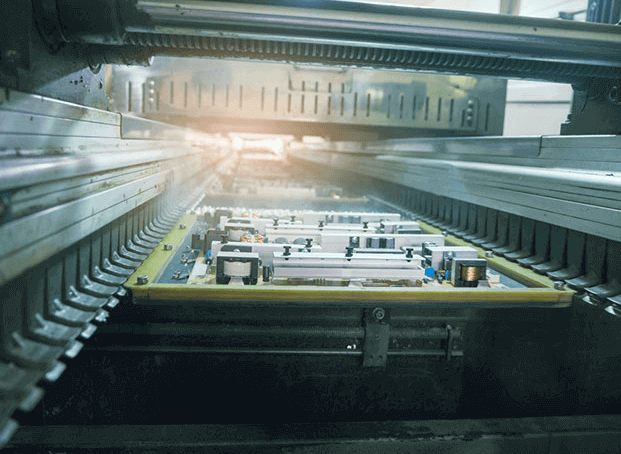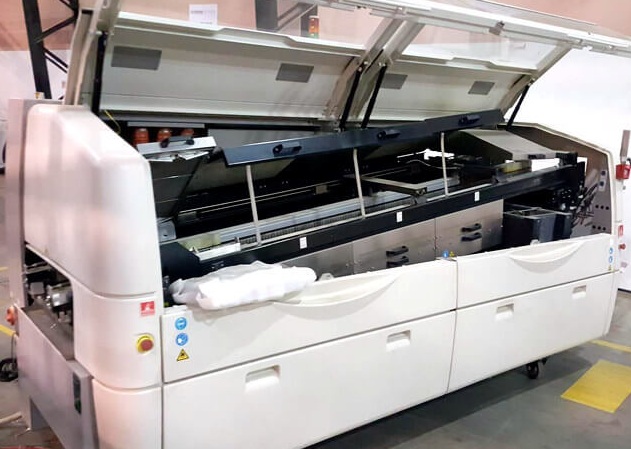Soldering is the process of connecting two metals by melting a solder and filling the joint with it. There are different soldering techniques available today. However, the basic purpose remains the same. All the techniques may not be suitable for all purposes. Where one technique fails, another technique produces effective soldering and creates strong joints between metals. Wave soldering is one such technique that uses a wave of solder to assemble electronic components, especially through-hole ones, on printed circuit boards (PCBs).
It is a bulk soldering process and is mostly used for commercial purposes. The main advantage of wave soldering is it is fast and can solder bulk quantities on PCBs in a short time. Besides, the process is affordable and it produces solid joints.
The following article explains the process of wave soldering, its advantages, and its practical applications.
Outline
ToggleWhat is Wave Soldering?
Wave soldering is a soldering technique used in electronics manufacturing, where a continuous wave of molten solder is used to create permanent connections between electronic components and printed circuit boards (PCBs).
In this process, the PCB is passed over a wave of molten solder, which wets the exposed metal pads on the board and creates solder joints. Unlike manual soldering, where each joint is individually soldered, wave soldering allows for the simultaneous soldering of multiple joints, making it highly efficient for mass production.
The wave soldering process can solder a complete board in a few seconds. Besides, it produces joints that are solid than the conventional soldering process. The joints are stable both electrically and mechanically. It is due to these reasons that wave soldering is preferred for assembling PCBs on a large scale for commercial purposes. You can use the wave soldering process mainly for hole-mounted components but sometimes for surface-mounted components as well.
But, the latest methods like infra-red reflow soldering is more suitable for surface mounted components on PCB. Hence, the use of wave soldering has considerably decreased in the last few years.
Pros of Wave Soldering
- Suitable for THT (Through Hole Technology) assembly
- Solders PCBs within a few seconds
- Preferable for mass assembly of commercial PCBs
- Very affordable
- Initiates less warpage
- Produces strong joints both mechanically and electrically
Equipment of Wave Soldering
The wave soldering machine serves as the central piece of equipment in the wave soldering process. It consists of several essential components, each playing a specific role in the soldering operation.
Firstly, the conveyor system facilitates the smooth movement of PCBs through the soldering process. Metal fingers/clamps hold the board tightly on a conveyor during the entire process. The metal fingers have a high melting point so that they can withstand the temperature and the solder. Titanium is one of the most commonly used metals for this purpose.
The fluxing station is a crucial component that applies flux to the PCB before soldering. It improves solderability by removing oxidation from metal surfaces and enhancing wetting characteristics.
Following fluxing, the PCBs enters the preheating zone. Here, they undergo gradual heating to prepare for the main soldering process. This preheating step is vital as it helps prevent thermal shock to sensitive components and promotes proper solder flow.
Next, the solder wave, the heart of the wave soldering machine, creates the actual solder joints by flowing over the exposed metal pads on the PCB. You should set the height of the soldering wave so that it does not flow over the top side of the board.
Finally, the cooling zone rapidly cools the soldered PCB to solidify the solder joints and prevent defects such as solder bridging or component damage due to excessive heat.
Wave Soldering Process Steps
Preparation
There are two main steps involved in processing electronics PCBs using a wave soldering machine. They are as follows,
Solder Resist Layer
The first step is to coat a layer of solder mask or solder resists over the PCB. It protects the PCB from oxidation and prevents the solder bridge. The solder mask covers all areas of the PCB except the parts where you need to solder i.e., the copper pads.
In most cases, the solder mask is in green color which increases the copper pads’ visibility. But depending on the design of the end product, the solder mask color can be selected to complement the appearance of the overall product. Blue and red are the other common solder mask colors.
Pad Spacing
While coating the solder mask, you have to ensure that there is enough space between the solder pads. If two solder pads are too close to each other, it may cause a solder bridge. A solder bridge is a connection formed by two solder pads that were not meant to be connected. This unintentional connection can lead to short circuits.
Besides, you have to consider the direction of the solder wave and the board direction. Solder bridges are prone to occur frequently in the direction of solder flow. So, solder pads in the direction of solder the wave should have more spacing between them than the pads that are located at right angles to the solder wave.
Fluxing
Before starting the actual soldering process, PCBs enter a fluxing station where you have to apply flux over the PCB. The flux removes the oxidation layer that is present on the surface of the board. Besides, it also prevents the formation of new oxidation layers.
Fluxes come in various types, including rosin-based, water-soluble, and no-clean fluxes. You should be careful not to apply too much flux. Otherwise, the excess flux will degrade the quality of the board. On top of that, it will also spoil the appearance of the board. Contrarily, if you use little flux, it will increase the risk of developing poor joints.
Various fluxing methods exist, including spray, foam, and wave fluxing. Each method offers unique advantages in terms of application precision and flux coverage.
Spray Flux
As the name suggests, the flux is sprayed over the underside of the board. Then, you have to use a compressed air jet to remove the excess flux.
Foam Flux
In this, a tank is filled with flux and a plastic cylinder with holes is immersed into it. A metal chimney covers the plastic cylinder and the air is forced through the cylinder. As a result of this, the flux rises. When a PCB passes over this flux foam, the flux is applied over the surface.
Preheating
In the wave soldering process, PCBs are subjected to greater levels of heat than in other soldering processes. Due to this high temperature, PCBs and the electronic components on them may undergo a thermal shock, which occur when the temperature rises suddenly. The thermal shock can cause the board or components to fail.
To prevent this, PCBs undergo a process of preheating so that their temperature rises gradually. Preheating of PCBs is done using heaters that produce hot air. The heaters blow hot air over the PCBs before they pass towards the wave soldering machine.
In some cases, infra-red heaters are used to preheat the PCBs. This heats the PCB uniformly without any hot and cold spots.
Apart from preventing thermal shocks, preheating also activates the flux. The flux then removes the oxidation layer and makes the surface clean for soldering.
Soldering
The core of the wave soldering process is, well, the soldering. It involves application of molten solder to create permanent connections between components and the PCB. The solder wave, typically composed of a eutectic solder alloy, flows over the exposed metal pads, forming solder joints through the process of wetting and solidification.
Controlling the contact time and temperature of the solder wave is crucial for achieving reliable and consistent solder joints. Factors such as conveyor speed, solder wave height, and solder alloy composition are very important to optimize soldering parameters.
Cooling
Following soldering, the cooling stage rapidly solidifies the solder joints, stabilizing the assembly and preventing defects. Various cooling methods, including forced air cooling and water quenching, may be employed depending on the specific requirements of the assembly and production environment.
Controlled cooling is critical to prevent thermal stress on components and maintain the integrity of the solder joints. Proper cooling minimizes the risk of defects such as solder fractures and improves the overall reliability of the soldered assembly.
Applications of Wave Soldering in PCB Assembly
In recent years, the use of wave soldering has decreased considerably. This is because the process is not suitable for soldering surface-mounted components and fine pitch components used in the boards today.
Besides, there are other new procedures such as infra-red reflow soldering that do a better job in soldering the above-mentioned type of boards.
Yet, still, the wave soldering process is most commonly used for conventionally leaded components. They are suitable for mass assembling of PCBs as they can solder them within a short time frame.
Frequently Asked Questions
What is the difference between reflow soldering and wave soldering?
In wave soldering, PCBs are soldered by passing them through a wave of solder. Whereas in reflow soldering, hot air is used to melt the solder paste and thus soldering the electronic components on the board.
What are the advantages of wave soldering?
Wave soldering is ideal for soldering THT (Through Hole Technology) assembly. Besides, the process is affordable and can solder bulk PCBs in a short time. Hence, it is preferable for commercial soldering.
Why is the use of wave soldering decreasing?
Wave soldering is not suitable for soldering surface-mounted components. Besides, other soldering techniques such as infra-red reflow soldering are preferred over the wave soldering technique. Hence, its use has decreased considerably in recent years.
Why should you preheat the board in wave soldering?
When the temperature of the board increases suddenly, it will go into a thermal shock leading to its failure. To prevent this, the board undergoes a preheating process that raises its temperature gradually.
Conclusion
To sum it up, wave soldering can solder conventionally leaded components and some surface mount boards in a short time for mass production. Besides, the process is affordable and produces strong joints. However, lately, its use is decreasing as the modern boards require more fine pitches. Other soldering techniques are preferred over this in many cases.
For any other doubts or queries, you can contact us using the comments section. We will help you out. You can also post your opinions in the comments box.




